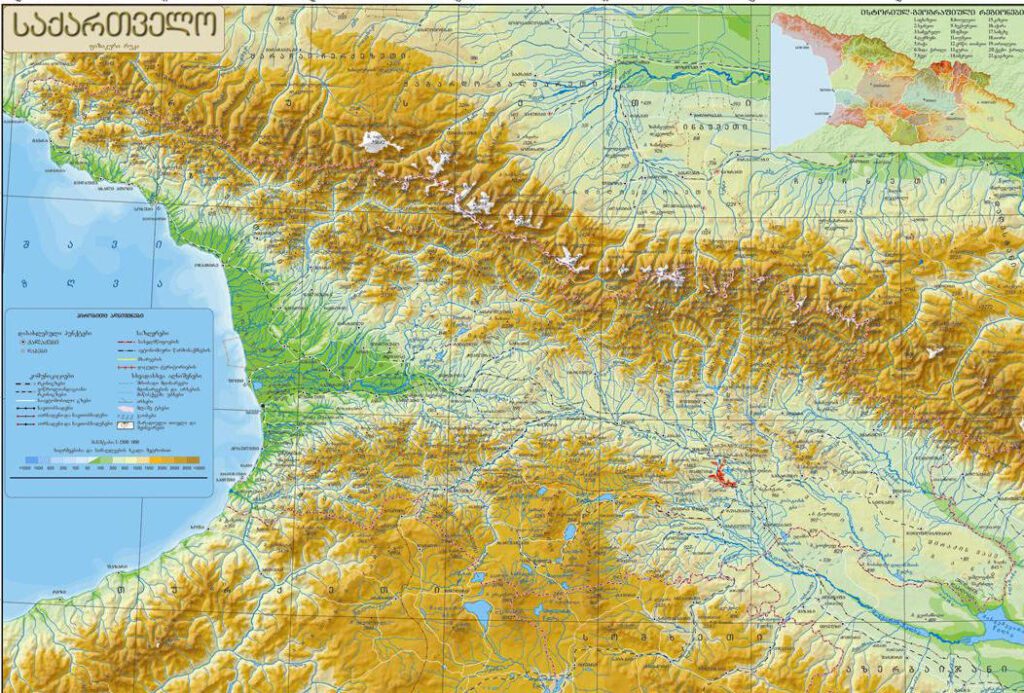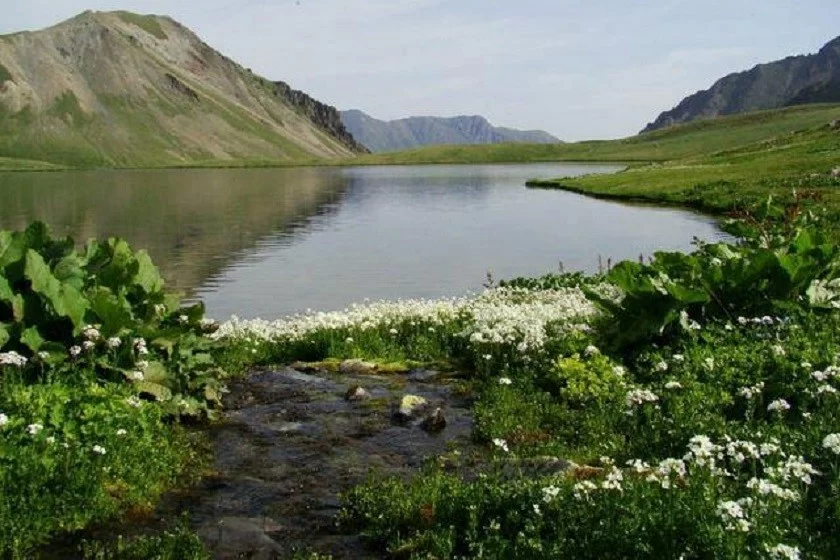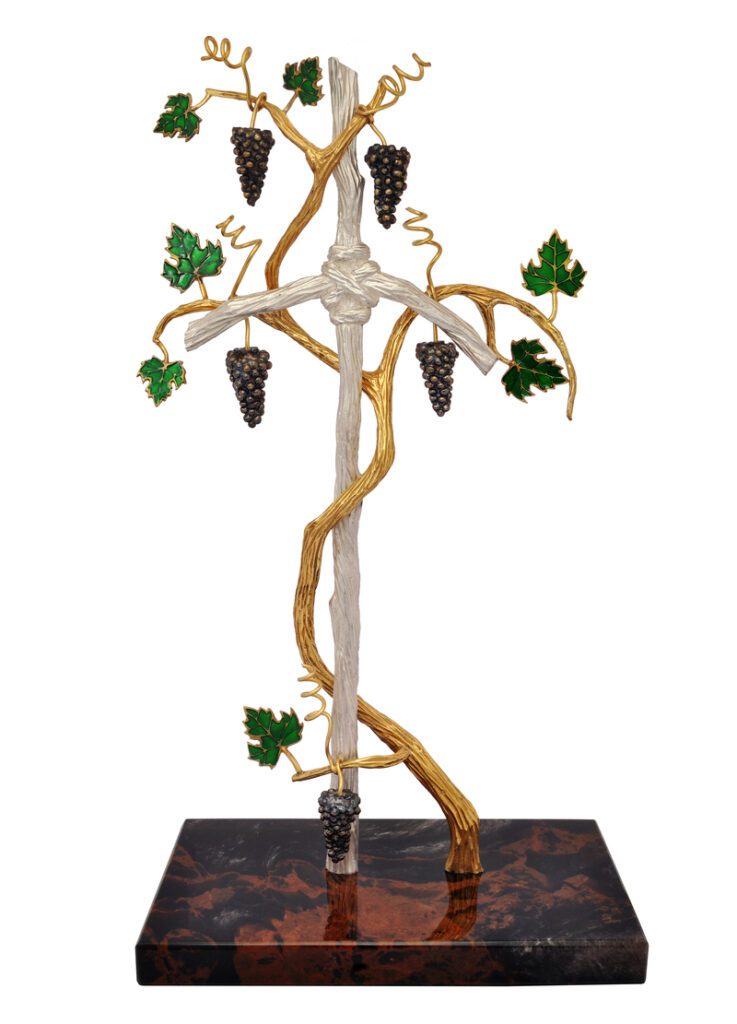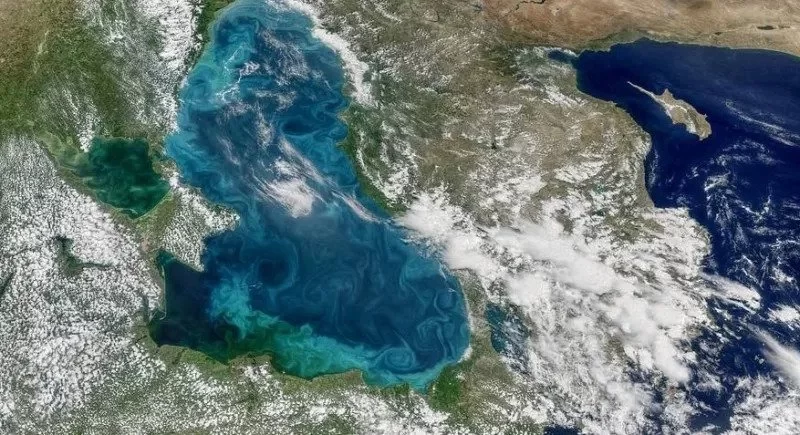The area: 69 700 km2;
Location: Black Sea Coast
Population: 3,720,400 people;
Language: The official language is Georgian, the only language in the Iberia-Caucasian family written in ancient script, with its own unique alphabet. English and Russian are also spoken.
Capital: Tbilisi
Climate: The west – subtropical climate; The east – continental climate;
The alpine edge starts from 2,100 m, but from 3,600 m there is constantly snow and frost.

Currency: Lari (GEL)
Avoid carrying large amounts of cash. Credit cards are increasingly being used in Georgia and ATMs can be found in major cities. Traveller’s cheques are not widely accepted.
Time zone: GMT (GMT +4)
Drives: On the right;
Internet TLD: ge;
Electricity: 220 V AC, 50 A, the standard dual-jack plug
Calling code: +995
Emergency(Police, Fire Rescue, Ambulance): 112
International Airports: Tbilisi, Kutaisi and Batumi

The Republic of Georgia is situated on the eastern shore of the Black Sea and bordered by Russia and the Caucasus Mountains to the north. Its neighbor to the east is Azerbaijan, to the south are Turkey and Armenia. Georgia is at a crossroads of European and Asian commerce, culture, and religion. Georgia is connected to the countries of the Black Sea by the Black Sea, and by the Bosphorus and Dardanelles straits – to the countries of the Mediterranean basin; Through the Strait of Gibraltar it is possible to connect with the whole world, and through the Danube – with the countries of Eastern and Central Europe.
The transport-geographic location of Georgia is currently very favorable. While in the Soviet Union, it was at a traffic “dead end” and communication with the countries of the world was carried out only through Moscow. After gaining independence, the country practically acquired the function of a transportation crossroads. The importance of Georgia’s favorable transport-geographical location has been confirmed and increased since then, when the foundation was laid for the construction of the Baku-Supsi and Baku-Tbilisi-Ceyhan oil pipelines. In 1998, an international agreement was signed in Baku on the creation of the Europe-Caucasus-Asia transport corridor, which will connect Western Europe and East Asia through the Caucasus and Central Asia. This corridor is called “traseka” for short. It is also worth noting the favorable recreational-geographical location of Georgia, as it is located between important tourist-recreational areas – the Caucasus and the Black Sea.
From the point of view of cultural-geographical location, our homeland is located between the cultural regions of Southeast Europe and the Middle East, which has a special effect on the country’s cultural life and socio-economic development.
Christianity arose during Judaism in AD. In the 1st century in the eastern part of the Roman Empire – in Palestine. Thanks to the Greek and Latin languages, the new doctrine spread easily throughout the Roman Empire. According to narration, Thomas preached in India and Persia, Andrew – in the Caucasus and the Balkans, Mark – in Egypt. According to the Christian tradition, the fate of the first Christians was hard, they were persecuted, ridiculed, various accusations were made. Peter and Paul were tortured in Rome in 64, John was the last of the apostles to die. The apostles were replaced by the church fathers. According to Christian narration, they were also persecuted, tortured and killed. Defenders of Christianity soon appeared in the Roman Empire itself. Emperor Constantine believed after the famous “miracle” and allowed worship. This is how a new humanistic doctrine gradually made its way. The Popes of Rome sought to subjugate the Eastern Christian Church and stir up conflict with the Patriarchs of Constantinople over religious issues. In 1054, the Pope of Rome sent his ambassadors – legates to Constantinople. The legates placed a deed containing the curse of the Greek Church on the altar of the Saint Sophia Cathedral. The Greek clergy burned the letter and in turn cursed the Pope. Because of this, in 1054, the Western and Eastern Christian churches finally split. The Eastern Church was called Orthodox, and the Western Church was called Catholic The Catholic Church is still centralized and subordinate to the Pope, while the Orthodox Church is decentralized into autocephalous churches. Priestly service in the Catholic Church was performed only in Latin until the reforms of the 1960s (Vatican II Council), and in the Orthodox Churches – in national languages.

The Roman historian Sozomenes directly indicated that “the Christianization of Kartli took place around the year 325 (the first Church Council of Nicaea)”.Ivane Javakhishvili considered 337 as the approximate date of conversion to Christianity (the death date of Constantine the Great). The recognition of Christianity as the state religion was an important step forward for the development of the people and the country. Christian faith had a significant influence on the foreign orientation of the Georgian society and the state, it strengthened the connection with Rome and opposed the aggressive policy of Iran. We can also mention that Christianity has existed in Georgia since the first century, but it was more important to declare it as the state religion, because it united people and brought them closer to each other.
Apostolic Autocephalous Orthodox Church of Georgia is one of the oldest local autocephalous Orthodox Apostolic Churches. The area of activity of the church is mainly Georgia, although it has dioceses in other countries as well. Due to occupation by Russia, it cannot exercise jurisdiction in Abkhazia and Tskhinvali region. The governance of the Church of Georgia is regulated by the management-board regulation adopted in 1995. The highest governing body is the church assembly consisting of secular and clerical persons, which is convened as needed. Between congregations, the Catholicos-Patriarch of All Georgia, who is elected by secret ballot at the congregation, leads the church. His enthronement takes place in Svetitskhovli Cathedral. The Patriarch manages the Church together with the Holy Synod. The episcopal candidate is chosen by the patriarch and presented to the synod. The Patriarch manages the Church through the institutions of the Patriarchate of Georgia. The Patriarchate has several departments, two academies, four seminaries, the Patriarchate has its own mass media: press, radio and television.
There are three types of Georgian script: Mtavruli, Nuskhuri and Mkhedruli. The oldest of them is Mtavruli. Each of them has a characteristic graphic style, however, in terms of the variation of letter outline, Nuskhuri is the result of the development of Asomatruli, and Mkhedruli is the result of Nuskhuri. Examples of Nuskhuri script can be found from the 9th century, but manuscripts written entirely in Nuskhuri exist only from the 12th century. Along with nuskhuri, Asomatruli was still used for epigraphic inscriptions, as well as for titles and superscripts in manuscripts.

Nuskuri script is still used in church literature. The modern Georgian alphabet is called Mkhedruli, and examples of it can be found from the 11th century. There are 33 letters in the modern Georgian alphabet. There were 38 letters and signs in the old alphabet, of which 5 Ilia Chavchavadzeuli (Georgian writer, poet, publicist, public figure) are no longer used after the reform.
On the initiative of the National Agency for the Protection of Cultural Heritage of Georgia, in March 2015, three types of the Georgian alphabet – Asomaturli, Nuskhur and Mkhedruli, were granted the status of an intangible national cultural heritage under the name “Living culture of three types of the Georgian alphabet”, and on November 30, 2016 UNESCO included it in the representative list of intangible cultural heritage of humanity.

In the relatively small territory of Georgia, there are almost all air zones on the earth’s surface, starting from the humid subtropical, ending with the zone of eternal snow and glaciers. The variety of weather in Georgia is determined on the one hand by its location on the northern border of the subtropical zone between the Black and Caspian seas, on the other hand by the special complexity of its relief: ridges of different directions and heights play a major role in shaping the weather. The local air is created by the Black Sea and the Caucasus. The latter protects Georgia from the direct invasion of cold air masses from the north, and the Black Sea moderates temperature fluctuations and contributes to the arrival of large amounts of precipitation, especially in western Georgia.
